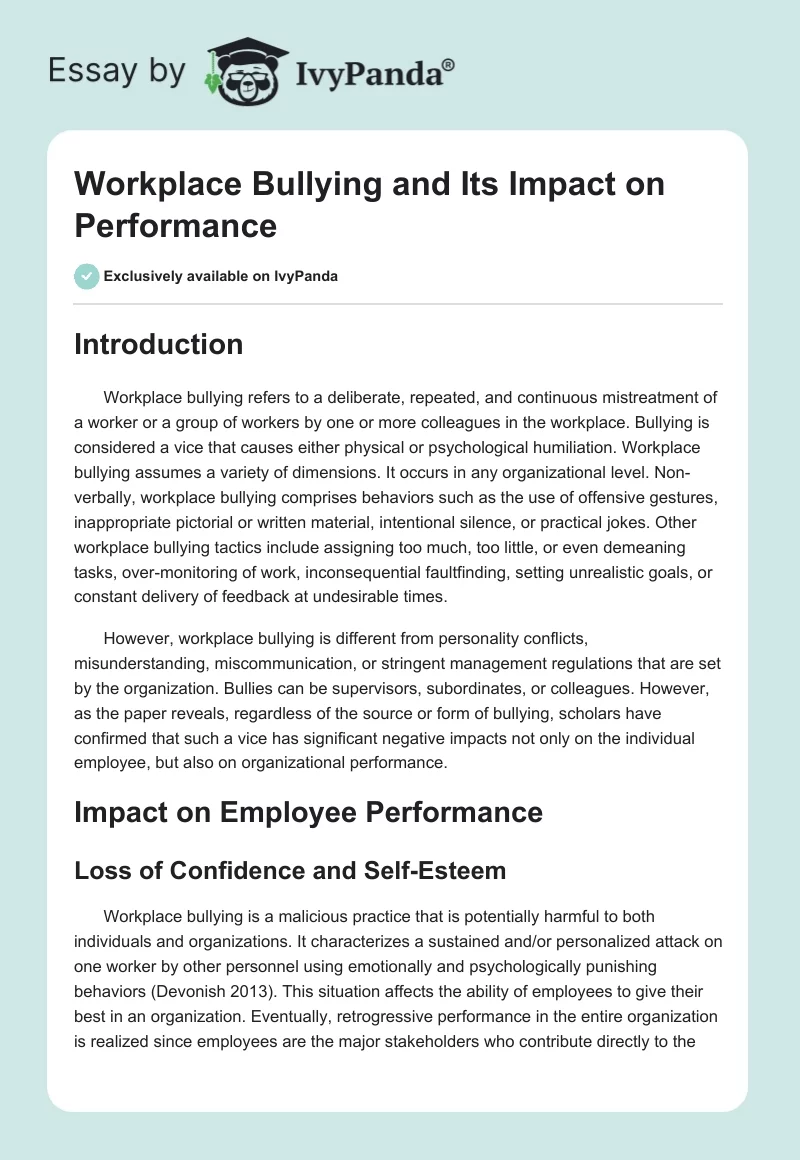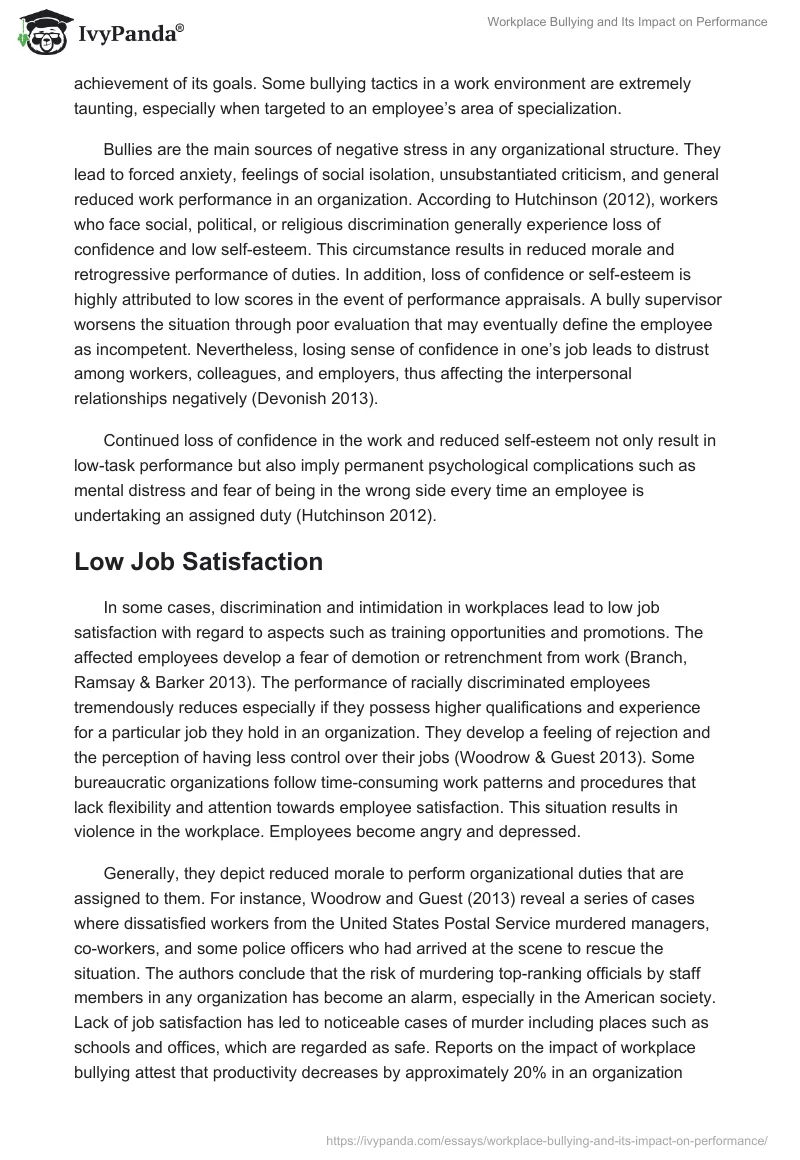Introduction
Workplace bullying refers to a deliberate, repeated, and continuous mistreatment of a worker or a group of workers by one or more colleagues in the workplace. Bullying is considered a vice that causes either physical or psychological humiliation. Workplace bullying assumes a variety of dimensions. It occurs in any organizational level. Non-verbally, workplace bullying comprises behaviors such as the use of offensive gestures, inappropriate pictorial or written material, intentional silence, or practical jokes. Other workplace bullying tactics include assigning too much, too little, or even demeaning tasks, over-monitoring of work, inconsequential faultfinding, setting unrealistic goals, or constant delivery of feedback at undesirable times.
However, workplace bullying is different from personality conflicts, misunderstanding, miscommunication, or stringent management regulations that are set by the organization. Bullies can be supervisors, subordinates, or colleagues. However, as the paper reveals, regardless of the source or form of bullying, scholars have confirmed that such a vice has significant negative impacts not only on the individual employee, but also on organizational performance.
Impact on Employee Performance
Loss of Confidence and Self-Esteem
Workplace bullying is a malicious practice that is potentially harmful to both individuals and organizations. It characterizes a sustained and/or personalized attack on one worker by other personnel using emotionally and psychologically punishing behaviors (Devonish 2013). This situation affects the ability of employees to give their best in an organization. Eventually, retrogressive performance in the entire organization is realized since employees are the major stakeholders who contribute directly to the achievement of its goals. Some bullying tactics in a work environment are extremely taunting, especially when targeted to an employee’s area of specialization.
Bullies are the main sources of negative stress in any organizational structure. They lead to forced anxiety, feelings of social isolation, unsubstantiated criticism, and general reduced work performance in an organization. According to Hutchinson (2012), workers who face social, political, or religious discrimination generally experience loss of confidence and low self-esteem. This circumstance results in reduced morale and retrogressive performance of duties. In addition, loss of confidence or self-esteem is highly attributed to low scores in the event of performance appraisals. A bully supervisor worsens the situation through poor evaluation that may eventually define the employee as incompetent. Nevertheless, losing sense of confidence in one’s job leads to distrust among workers, colleagues, and employers, thus affecting the interpersonal relationships negatively (Devonish 2013).
Continued loss of confidence in the work and reduced self-esteem not only result in low-task performance but also imply permanent psychological complications such as mental distress and fear of being in the wrong side every time an employee is undertaking an assigned duty (Hutchinson 2012).
Low Job Satisfaction
In some cases, discrimination and intimidation in workplaces lead to low job satisfaction with regard to aspects such as training opportunities and promotions. The affected employees develop a fear of demotion or retrenchment from work (Branch, Ramsay & Barker 2013). The performance of racially discriminated employees tremendously reduces especially if they possess higher qualifications and experience for a particular job they hold in an organization. They develop a feeling of rejection and the perception of having less control over their jobs (Woodrow & Guest 2013). Some bureaucratic organizations follow time-consuming work patterns and procedures that lack flexibility and attention towards employee satisfaction. This situation results in violence in the workplace. Employees become angry and depressed.
Generally, they depict reduced morale to perform organizational duties that are assigned to them. For instance, Woodrow and Guest (2013) reveal a series of cases where dissatisfied workers from the United States Postal Service murdered managers, co-workers, and some police officers who had arrived at the scene to rescue the situation. The authors conclude that the risk of murdering top-ranking officials by staff members in any organization has become an alarm, especially in the American society. Lack of job satisfaction has led to noticeable cases of murder including places such as schools and offices, which are regarded as safe. Reports on the impact of workplace bullying attest that productivity decreases by approximately 20% in an organization where employees have low morale and/or dissatisfaction. This observation has a direct influence on individual and organizational performance (Galanaki & Papalexandris 2013).
Health
Workplace bullying creates stressful environments. Galanaki and Papalexandris (2013) released some inferences that were drawn from an online survey that analyzed unhealthy workplaces. This survey indicated how workplace bullying results in permanent harm to the affected employees. Statistics further indicated that an estimated time range of 10% – 52% is wasted as employees seek solutions and support from the management. Failed defense of their situation worsens as they become demotivated and more stressful (Galanaki & Papalexandris 2013).
In a separate research that was conducted to evaluate high-work demands in the public sector, it is evident that less control and poor social support lead to stressful work environments (McCormack, Djurkovic & Casimir 2013). Most of the workplace bullying takes place behind the scenes. It is difficult to detect except where workers emerge in vengeful drama to counter bullies at work. Bullies shame, victimize, humiliate, and depress other workers who instill fear, anger, anxiety, and fewer psyches in them. This mistreatment leads to negative impacts on their health with high prevalence of heart-related diseases, mental failures, lack of sleep and digestive disturbances, nightmares, exhaustion, poor concentration, and depression. Other workers result into alcoholism, which leads to absenteeism, family tension, and even accidents (Devonish 2013). These effects bring about counter-productivity due to reduced task performance.
Impact to the Organizational performance
Cost
Bullying in the workplace has both direct and indirect costs to the organization. Costs that are incurred directly include absenteeism, increased employee turnover rates, high legal fees, and insecurity. On the other hand, indirect costs are difficult to measure in terms of employee reduced morale and retrogressive productivity (Devonish 2013). Individual consequences because of bullying in the workplace are very costly for the organization. Woodrow and Guest (2013) classify these costs into three categories. In the first category, the organization meets the cost of hiring other staff members to replace those who leave jobs because of workplace bullying. Further, cost is incurred during recruitment and training of new staff members to take the positions left vacant by the leaving employees.
The second category of cost comes in as new workers cope with the conditions of their newly acquired jobs. The efforts at the time of adapting to new tasks and perhaps experience in bullying reduce greatly. In the third category, bullied employees may end up with short-term or long-term illnesses, injuries, or disabilities. In this case, bullying costs the organization while carrying out investigations into the cause of illnesses, injuries, and disabilities. Furthermore, the organization also meets servicing costs of legal actions in an attempt to retain its reputation (Woodrow & Guest 2013).
High Turnover Rates
Devonish (2013) describes workplace bullying as an intentional or non-intentional malicious behavior that targets a certain individual or a group of interest to harm, control, or drive a coworker from the workplace. Organizations face a high risk of losing employees in case of stressful working environments. At the highest pressure resulting from workplace bullying, employees give up and vacate jobs to cope with stress. Galanaki and Papalexandris (2013) released some results from an online survey that indicated that about 82% of bullied workers leave their workplace.
The outcome showed about 38% of workers who left their occupation because of health-related issues while 44% gave up because of attaining low scores in performance appraisals that were conducted by bully supervisors, hence regarding them as incompetent. This research vividly gave the advantage of withdrawing from a job over disadvantages that accompany spending time while defending bully-related issues and/or seeking support helplessly, losing motivation, or even taking a sick leave.
Economic Loss
Bullying at the workplace to leads to high rates of absenteeism as employees take short involuntary leaves to cope with bullying tactics in the workplace. This situation results in decreased commitment to the organization, thus leading to declined efficiency and productivity (Hutchinson 2012). Generally, declined productivity in an organization highly affects its output. Bullying results in high turnover rates as employees escape oppressive environments (Australian Human Rights Commission 2011).
This case leads to joblessness, which is the implication of economic loss to organizations and the nation as a whole. Furthermore, employees who leave due to injuries and mental illnesses require medical attentions, which contribute to economic losses to organizations since they incur insurance costs to cover hospital bills and sometimes settle legal fees that maybe charged as compensation for the bullied employees (McCormack, Djurkovic & Casimir 2013).
Workplace bullying is a detrimental phenomenon that exhibits far-reaching economic consequences to individuals and organizations. It leads to physical, emotional, and psychological damages to employees who in turn have to incur costs of restoring their conditions. The impacts of such behavior prove tremendous to the operations of the organization in terms of reducing its rates of performance both internally through decreased output and externally by bringing about economic losses. However, despite the recognition of bullying in many organizations, there are rarely controlled regulations and legal protections to address its vulnerability
Conclusion
Bullying is a phenomenon that is difficult to deal with in an organizational setup. However, the practice can be discouraged through formulation of organizational policies, conflict management tactics, and education. Organizations should put forth stringent rules and zero-tolerance policies that govern the conduct of employees at work. Formulation of workplace bullying policies should involve the knowledge and creativeness of the employees where possible. Organizations should educate and train employees on how to deal with bullying instances from supervisors or colleagues at work. In addition, management departments should encourage employees to report instances of bullying.
Bullies should receive counseling and/or be subjected to appropriate punishments as stipulated in the set policies. Decreased bullying instances greatly improve the motivation of workers and hence the individual performance. Furthermore, it reduces costs that are incurred by the organization while dealing with the aftermaths of bullying. Conclusively, individual and organizational performances relate to workplace bullying.
References
Australian Human Rights Commission 2011, Workplace Bullying: Violence, Harassment and Bullying Fact Sheet. Web.
Branch, S, Ramsay, S & Barker, M 2013, ‘Workplace Bullying, Mobbing and General Harassment: A Review’, International Journal of Management Reviews, vol. 15 no. 1, pp. 280-299. Web.
Devonish, D 2013, ‘Workplace bullying, employee performance and behaviors’, Employee Relations, vol. 35 no. 6, pp. 630-647. Web.
Galanaki, E & Papalexandris, N 2013, ‘Measuring workplace bullying in organizations’, The International Journal of Human Resource Management, vol. 24 no. 11, pp. 2107-2130. Web.
Hutchinson, J 2012, ‘Rethinking Workplace Bullying as an Employment Relations Problem’, The Journal of Industrial Relations, vol. 54 no. 5, pp. 637-652. Web.
McCormack, D, Djurkovic, N & Casimir, G 2013, ‘Workplace bullying: then experiences of building and construction apprentices’, Asia Pacific Journal of Human Resources, vol. 51 no. 4, pp. 406-420. Web.
Woodrow, C & Guest, D 2013, ‘When good HR gets bad results: exploring the challenge of HR implementation in the case of workplace bullying’, Human Resource Management Journal, vol. 24 no. 1, pp. 38-55. Web.


